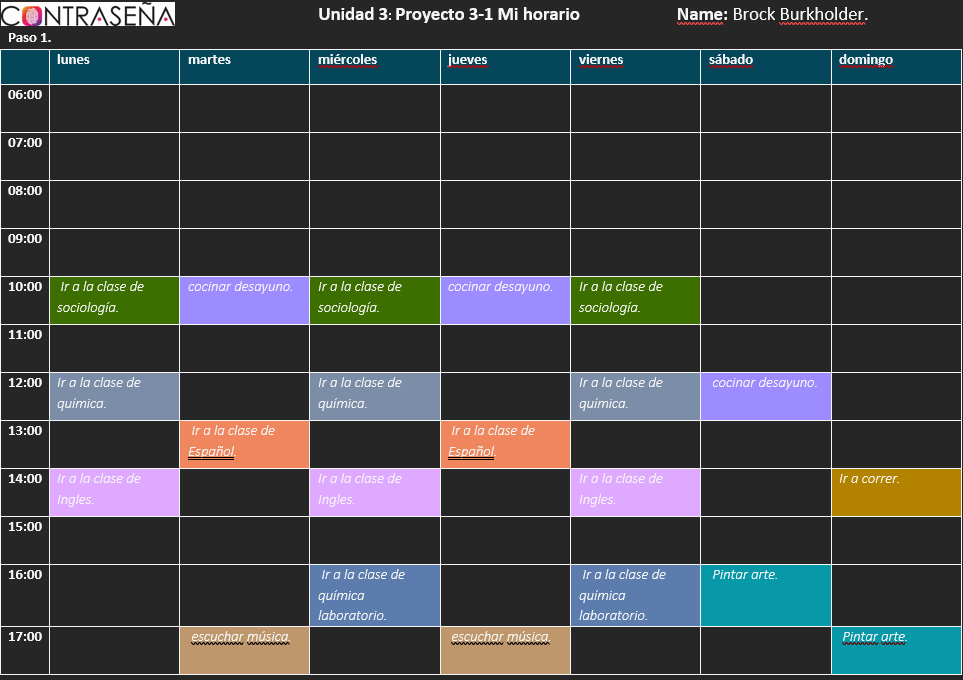Interpretive, Interpersonal, and Presentational Modes of Communication
Reflection
- In Spanish 101, I learned the fundamentals to understanding the language as well as its differences and similarities to English. Some of the most challenging aspects for me to accomplish were understanding when to conjugate verbs, such as “yo cocino” instead of “yo cocinar.” Through putting effort into understanding the proper ways to use these conjugations in the classroom as well as at home, I’ve been able to develop a firm understanding of the basics in speaking Spanish. Lingrohub has been very helpful in showing me the proper ways in which to utilize these verbs, as well as understand anything else I may have had trouble with through the class. I liked that I was able to go back at any time throughout lesson during the whole semester and review what I needed when needed. I am happy to say that I believe my pronunciation is fairly good, that was one of the easiest aspects of the class for me to pick up. This has been useful for developing a good understanding of how to speak the language properly.
Artifacts
Below is a video in which I presented my favorite places to go to throughout the school, this video was a project for the class towards the end of the semester. It accurately reflects my understanding of the language so far.
Exploring Culture
The class actually taught me different values and perspectives that many Spanish speaking people have across different countries. An example of this is the word “Siesta” which means to rest in the afternoon of the day, sometimes after eating. I also learned how many cultures treat school differently than in America, many in the United States are eager to move away to live in accommodations provided by the school, but many in South America prefer to live at home with family while they go to university.
Interpersonal Communication
Two-way communication, one-way communication.
Read and analyzed emails and text messages between students in Spanish, and formal as well as informal letters between students, professors, and faculty. Listened to different phrases and sentences, as well as monologues through LingroHub, and answered questions related to the dialogue. Viewed videos of students interacting with other students, as well as with the viewer while comparing learned material with what was being stated. Through these exercises, I was able to apply material I had learned through LingroHub and understand what I was reading, viewing, or listening to. When asked questions in Spanish that I didn’t immediately know the answer to, I could work out what was being stated to me, so I could come up with a reasonable answer.
Presentational Speaking
I completed a presentation in which I had to state which areas of my school I liked, and why I like them as well as where they are, the video is posted above. I also had to conduct an interview with another student where I would ask them questions in Spanish, and they would respond in Spanish. This was helpful in showing me how to speak the language more clearly, and also helped me to communicate more fluently with others.
Presentational Writing
In Spanish, I composed a schedule that showed my daily routine throughout the week.

Composing a schedule with my week for the month in Spanish allowed to utilize the Spanish terms for activities and obligations I learned about earlier in the semester and apply them to a calendar. Each day states an obligation or activity I do. Doing this allowed me to learn how to create future schedules for myself and for others in Spanish if needed, which is useful.
Interpretive Listening
Through one of my lingroHub assignments, I listened to a woman discuss her favorite areas in her school, such as the cafeteria, library, and her dorm room. Because of the material I had learned earlier in the semester, I was able to understand her and comprehend what she was referring to when she showed these areas. Though I admit there were some words I hadn’t understood or heard before, her body language actively showed what she was feeling and referring to which helped me to understand what she was saying.
Interpretive Reading
During the semester, I had a variety of different texts and emails to analyze while answering questions related to the text. These exercises helped me to analyze what words did and didn’t make sense and helped me to understand what I should say when having a discussion with someone. Below is an email (provided through Contrasena’s LingroHub) in which a student writes to his parents, and I answered questions and filled in blanks that were in the email that helped it to make sense.
¡Hola a todos! Después de terminar la primera semana de clases, tengo mucho que contarles. Me gusta la clase de filosofía. Va a ser una clase muy difícil pero es obvio que la profesora va a enseñar la clase muy bien y que va a calificar los exámenes de manera muy justa. Vamos a leer muchos libros clásicos que o tengo que sacar de la biblioteca o tengo que comprar en la librería. Vamos a usar las computadoras todos días en clase para escribir ensayos en grupo. La profesora es muy moderna y tenemos clases virtuales. Los estudiantes tienen que participar en videochats cada semana. Con cariño, Iván.